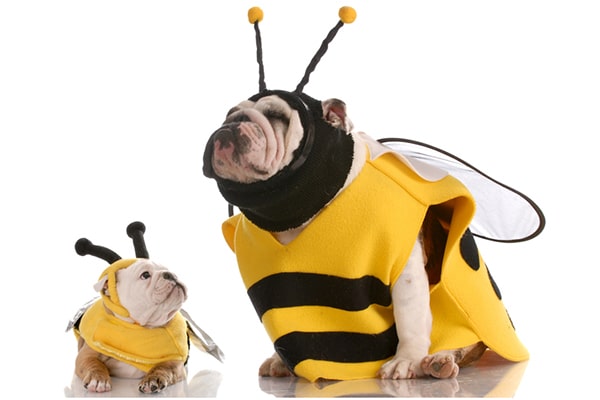The post How to Handle Bites & Stings in Dogs by Catherine Ashe appeared first on Dogster. Copying over entire articles infringes on copyright laws. You may not be aware of it, but all of these articles were assigned, contracted and paid for, so they aren’t considered public domain. However, we appreciate that you like the article and would love it if you continued sharing just the first paragraph of an article, then linking out to the rest of the piece on Dogster.com.
Most of us have been there — an innocent frolic outside with our canine companion leads to a swollen face and hives. Just like their human counterparts, dogs are susceptible to insect and animal bites and stings. These are the ones with cause for concern.
Dog stung by a bee or dog stung by a wasp

Dogs dressed as bees are cute – but dogs stung by bees sure aren’t! Photography by John Mcallister/Thinkstock.
These are extremely common in the spring and summer when insects are the most active. Some dogs will suffer absolutely no ill effects other than mild redness, swelling and discomfort at the site of a sting (much like humans). And, like humans, some dogs develop hives, facial swelling and welts. These can be managed at home with doses of diphenhydramine (brand name Benadryl). First consult your veterinarian on appropriate dosing.
In severe cases, anaphylaxis can develop. A canine having an anaphylactic reaction will begin to:
Take your dog immediately to emergency care. Your dog will be treated with epinephrine, IV fluids and other supportive care measures. The veterinarian may also recommend carrying an EpiPen for future reactions.
Spider bites on dogs
The two most common venomous spiders in the United States are the widows (Latrodectus sp.) and recluses (Loxosceles sp.). These spiders are timid and tend to live in dark, dry places. This is good for our animal friends, as they don’t come into contact as frequently. It is rare to know for certain that your dog was bitten by a spider, as these species are small and often in places where curious noses can reach but humans do not see.

Black widow spider. Photography ©stephanie phillips | Getty Images.
Widows can be lethal. Dogs are more resistant to the venom than cats, but a small dog could be in trouble. The symptoms are surprising. It can take 8 hours for signs to develop. They include:
- marked pain
- muscle cramps
- diarrhea and vomiting
- agitation and vocalizing
- facial tremors
- a rigid abdomen
Unlike recluse spiders, the wound itself often has no noticeable signs other than mild redness and swelling.
An antivenin does exist, but it is not routinely carried in veterinary clinics. It is costly, and it’s rare to confirm an actual bite. The good news is that the majority of dogs will survive a bite without antivenin. Further, some entomologists estimate that 15 percent of bites are “dry” — meaning that no venom is injected. If you suspect a widow bite, seek veterinary care.

Brown recluse spider. Photography ©Schiz-Art | Getty Images.
Recluse bites are different and often cause significant localized tissue damage (necrosis). The bite site might go through the following stages:
- a small blister shows
- the blister turns black
- the tissue peels away
Systemic signs are uncommon. Oftentimes, wound care is needed over several days, as well as pain management and antibiotics. These bites are rarely fatal.
Snake bites on dogs

Rattlesnake. Photography ©texcroc | Getty Images.
There are about 20 venomous snakes in the United States including rattlesnakes and copperheads. Which your dog could be exposed to depends on where you live. The severity of the bite depends on many different factors including how much venom was injected and how many bites occurred. Most emergency veterinary clinics stock antivenin appropriate for the snakes in their areas.
There are many “old school” remedies that simply do not work. Do not apply a tourniquet or ice the leg. Avoid over-the-counter pain medications. Keep calm and drive to the nearest emergency veterinary clinic.
All snake bites should be evaluated by a veterinarian. In some cases, “dry” bites do occur (no venom injected) and usually pain management is sufficient. In other cases, more aggressive measures such as IV fluids, antivenin, pain relief and close monitoring are needed. Some snake bites cause localized damage while others cause systemic effects like clotting abnormalities and seizures.
Scorpions

Scorpion. Photography ©Ledzeppelinriff | Getty Images.
Only one scorpion species in the United States is thought to cause signs of systemic envenomation: the bark scorpion. Found almost exclusively in Arizona, it hides under tree bark. Symptoms are generally neurologic:
- rhythmic jerking
- flicking of the eyes
- marked pain both at the site and referred (pain felt elsewhere).
There is no specific antidote in dogs. Care is supportive, and death is very rare. As with any envenomation, do not panic if you suspect your dog has been stung. Seek veterinary evaluation.
Thumbnail: Photography ©kozorog | Getty Images.
About the author
Catherine Ashe is a veterinarian, mother and freelance writer residing in Asheville, North Carolina. For nine years, she practiced emergency medicine and is now a relief GP. When not working, she spends time with her family of six, reading, writing and enjoying the Blue Ridge mountains.
Editor’s note: This article appeared in Dogster magazine. Have you seen the new Dogster print magazine in stores? Or in the waiting room of your vet’s office? Subscribe now to get Dogster magazine delivered straight to you!
Read more about dog health and care on Dogster.com:
The post How to Handle Bites & Stings in Dogs by Catherine Ashe appeared first on Dogster. Copying over entire articles infringes on copyright laws. You may not be aware of it, but all of these articles were assigned, contracted and paid for, so they aren’t considered public domain. However, we appreciate that you like the article and would love it if you continued sharing just the first paragraph of an article, then linking out to the rest of the piece on Dogster.com.
No comments:
Post a Comment